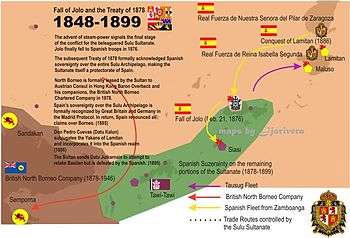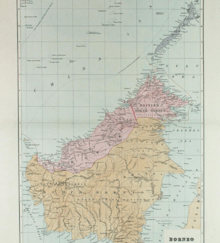Madrid Protocol of 1885
The Madrid Protocol of 1885 is an agreement between Great Britain, Germany and Spain to recognise the sovereignty of Spain over the Sulu Archipelago as well as the limit of Spanish influence in the region.[1] Under the agreement, Spain relinquishes all claim to Borneo.
The Spanish Government renounces, as far as regards the British Government, all claims of sovereignty over the
territories of the continent of Borneo, which belong, or which have belonged in the past to the Sultan of Sulu (Jolo), and which comprise the neighbouring islands of Balambangan, Banguey, and Malawali, as well as all those comprised within
a zone of three maritime leagues from the coast, and which form part of the territories administered by the Company styled the “British North Borneo Company”.
— Article III, Madrid Protocol of 1885

Another important point regarding the agreement relates to Article IV which guarantees of no restriction on trade to the parties of the protocol within the Archipelago and North Borneo.
North Borneo Dispute
The North Borneo dispute is the territorial dispute between Malaysia and the Philippines over much of the eastern part of the state of Sabah, a territory known as North Borneo prior to the formation of the Malaysian federation. The Philippines, presenting itself as the successor state of the Sultanate of Sulu, retains a "dormant claim" on Sabah on the basis that the territory was only leased to the British North Borneo Company in 1878, with the sovereignty of the Sultanate (and subsequently the Republic) over the territory never having been relinquished.[2] However, Malaysia considers this dispute as a "non-issue" as it interprets the 1878 agreement as that of cession[3] and that it deems that the residents of Sabah had exercised their right to self-determination when they joined to form the Malaysian federation in 1963.[4]
References
- Tregonning, H.G. (1970). The Philippine Claim to Sabah (PDF). The Malayan Branch of the Royal Asiatic Society.
- "East and Southeast Asia: the Philippines". CIA Factbook. Central Intelligence Agency. Archived from the original on 11 January 2010. Retrieved 7 March 2013.
- Campbell, Charlie (26 February 2013). "Sabah Standoff: Diplomatic Drama After Filipino Militants Storm Malaysia". TIME. Retrieved 16 March 2013.
- James W. Gould (1969). The United States and Malaysia. Harvard University Press. pp. 106–. ISBN 978-0-674-92615-8.
Further reading
- Leigh R. Wright. Historical Notes on the North Borneo Dispute. The Journal of Asian Studies, Vol. 25, No. 3 (May 1966), pp. 471–484.
- Leigh R. Wright. The Origins of British Borneo. Modern Asian Studies, Vol. 10, No. 1 (1976), pp. 149–154
- Leigh R. Wright. The Anglo-Spanish-German Treaty of 1885: A Step in the Development of British Hegemony in North Borneo. Australian Journal of Politics & History 18 (1), 62–75
